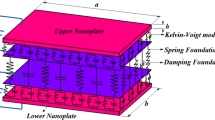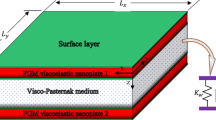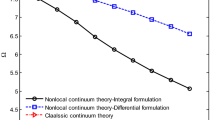Abstract
In this paper, vibration features of variable thickness rectangular viscoelastic nanoplates are studied. In order to consider the small-scale and the transverse shear deformation effects, governing differential equations and relevant boundary conditions are adopted based on the nonlocal elasticity theory in relation to first-order shear deformation theory of plates. The numerical solution for the nanoplate vibration frequencies is proposed applying the differential quadrature method, as a simple, effective and precise numerical tool. The present formulation and solution method are validated showing their fast convergence rate and comparison of results, in limited cases, using the available literature. Excellent agreement between the obtained and available results is observed. The effects of structural damping coefficient, boundary conditions, aspect ratio, nonlocal and variable thickness parameters on viscoelastic nanoplates vibration behaviour are studied in detail.








Similar content being viewed by others
References
Bunch JS, Van Der Zande AM, Verbridge SS, Frank IW, Tanenbaum DM, Parpia JM, Craighead HG, McEuen PL (2007) Electromechanical resonators from graphene sheets. Science 315(5811):490–493
Sakhaee-Pour A, Ahmadian M, Vafai A (2008) Applications of single-layered graphene sheets as mass sensors and atomistic dust detectors. Solid State Commun 145(4):168–172
Robinson JT, Zalalutdinov M, Baldwin JW, Snow ES, Wei Z, Sheehan P, Houston BH (2008) Wafer-scale reduced graphene oxide films for nanomechanical devices. Nano Lett 8(10):3441–3445
Milaninia KM, Baldo MA, Reina A, Kong J (2009) All graphene electromechanical switch fabricated by chemical vapor deposition. Appl Phys Lett 95(18):183105
Nemes-Incze P, Osváth Z, Kamarás K, Biró L (2008) Anomalies in thickness measurements of graphene and few layer graphite crystals by tapping mode atomic force microscopy. Carbon 46(11):1435–1442
Novoselov KS, Geim AK, Morozov S, Jiang D, Zhang Y, Dubonos SA, Grigorieva I, Firsov A (2004) Electric field effect in atomically thin carbon films. Science 306(5696):666–669
Gupta A, Chen G, Joshi P, Tadigadapa S, Eklund P (2006) Raman scattering from high-frequency phonons in supported n-graphene layer films. Nano Lett 6(12):2667–2673
Patil AJ, Vickery JL, Scott TB, Mann S (2009) Aqueous stabilization and self-assembly of graphene sheets into layered bio-nanocomposites using DNA. Adv Mater 21(31):3159–3164
Ni ZH, Wang HM, Ma Y, Kasim J, Wu YH, Shen ZX (2008) Tunable stress and controlled thickness modification in graphene by annealing. ACS Nano 2(5):1033–1039
Arroyo M, Belytschko T (2005) Continuum mechanics modeling and simulation of carbon nanotubes. Meccanica 40(4–6):455–469
Sudak L (2003) Column buckling of multiwalled carbon nanotubes using nonlocal continuum mechanics. J Appl Phys 94(11):7281–7287
Reddy J (2007) Nonlocal theories for bending, buckling and vibration of beams. Int J Eng Sci 45(2):288–307
Setoodeh A, Khosrownejad M, Malekzadeh P (2011) Exact nonlocal solution for postbuckling of single-walled carbon nanotubes. Phys E 43(9):1730–1737
Wang CM, Duan W (2008) Free vibration of nanorings/arches based on nonlocal elasticity. J Appl Phys 104(1):014303
Behfar K, Naghdabadi R (2005) Nanoscale vibrational analysis of a multi-layered graphene sheet embedded in an elastic medium. Compos Sci Technol 65(7):1159–1164
Aghababaei R, Reddy J (2009) Nonlocal third-order shear deformation plate theory with application to bending and vibration of plates. J Sound Vib 326(1):277–289
Ansari R, Sahmani S, Arash B (2010) Nonlocal plate model for free vibrations of single-layered graphene sheets. Phys Lett A 375(1):53–62
Eringen AC, Edelen D (1972) On nonlocal elasticity. Int J Eng Sci 10(3):233–248
Eringen AC (2002) Nonlocal continuum field theories. Springer, Berlin
Chen Y, Lee JD, Eskandarian A (2004) Atomistic viewpoint of the applicability of microcontinuum theories. Int J Solids Struct 41(8):2085–2097
Pradhan S, Phadikar J (2009) Nonlocal elasticity theory for vibration of nanoplates. J Sound Vib 325(1):206–223
Murmu T, Pradhan S (2009) Small-scale effect on the free in-plane vibration of nanoplates by nonlocal continuum model. Phys E 41(8):1628–1633
Wang Y, Li F-M, Wang Y-Z (2015) Nonlinear vibration of double layered viscoelastic nanoplates based on nonlocal theory. Phys E 67:65–76
Murmu T, Pradhan S (2009) Vibration analysis of nanoplates under uniaxial prestressed conditions via nonlocal elasticity. J Appl Phys 106(10):104301
Jomehzadeh E, Saidi A (2011) Decoupling the nonlocal elasticity equations for three dimensional vibration analysis of nano-plates. Compos Struct 93(2):1015–1020
Malekzadeh P, Setoodeh A, Beni AA (2011) Small scale effect on the free vibration of orthotropic arbitrary straight-sided quadrilateral nanoplates. Compos Struct 93(7):1631–1639
Phung-Van P, Nguyen-Thoi T, Luong-Van H, Thai-Hoang C, Nguyen-Xuan H (2014) A cell-based smoothed discrete shear gap method (CS-FEM-DSG3) using layerwise deformation theory for dynamic response of composite plates resting on viscoelastic foundation. Comput Methods Appl Mech Eng 272:138–159
Luong-Van H, Nguyen-Thoi T, Liu G, Phung-Van P (2014) A cell-based smoothed finite element method using three-node shear-locking free Mindlin plate element (CS-FEM-MIN3) for dynamic response of laminated composite plates on viscoelastic foundation. Eng Anal Bound Elem 42:8–19
Phung-Van P, Abdel-Wahab M, Liew K, Bordas S, Nguyen-Xuan H (2015) Isogeometric analysis of functionally graded carbon nanotube-reinforced composite plates using higher-order shear deformation theory. Compos Struct 123:137–149
Murmu T, Pradhan S (2009) Small-scale effect on the vibration of nonuniform nanocantilever based on nonlocal elasticity theory. Phys E 41(8):1451–1456
Janghorban M, Zare A (2011) Free vibration analysis of functionally graded carbon nanotubes with variable thickness by differential quadrature method. Phys E 43(9):1602–1604
Su Y, Wei H, Gao R, Yang Z, Zhang J, Zhong Z, Zhang Y (2012) Exceptional negative thermal expansion and viscoelastic properties of graphene oxide paper. Carbon 50(8):2804–2809
Pouresmaeeli S, Ghavanloo E, Fazelzadeh S (2013) Vibration analysis of viscoelastic orthotropic nanoplates resting on viscoelastic medium. Compos Struct 96:405–410
Malekzadeh P (2011) Three-dimensional thermal buckling analysis of functionally graded arbitrary straight-sided quadrilateral plates using differential quadrature method. Compos Struct 93(4):1246–1254
Sumelka W, Zaera R, Fernández-Sáez J (2015) A theoretical analysis of the free axial vibration of non-local rods with fractional continuum mechanics. Meccanica 50(9):2309–2323
Pourseifi M, Rahmani O, Hoseini S (2015) Active vibration control of nanotube structures under a moving nanoparticle based on the nonlocal continuum theories. Meccanica 50(5):1351–1369
Malik M, Bert C (1996) Implementing multiple boundary conditions in the DQ solution of higher-order PDEs: application to free vibration of plates. Int J Numer Methods Eng 39(7):1237–1258
Wang X, Bert C (1993) A new approach in applying differential quadrature to static and free vibrational analyses of beams and plates. J Sound Vib 162(3):566–572
Bert CW, Malik M (1996) Differential quadrature method in computational mechanics: a review. Appl Mech Rev 49(1):1–28
Shu C (2012) Differential quadrature and its application in engineering. Springer, Berlin
Singh B, Saxena V (1996) Transverse vibration of a rectangular plate with bidirectional thickness variation. J Sound Vib 198(1):51–65
Mlzusawa T (1993) Vibration of rectangular Mindlin plates with tapered thickness by the spline strip method. Comput Struct 46(3):451–463
Author information
Authors and Affiliations
Corresponding author
Appendices
Appendix 1: DQM brief view
Consider a continuous function f(x, y) consists of two different coordinates x and y. Based on DQM, the rth order derivative of f relative to x and the (r + s)th order derivative of f with respect to x and y are estimated as [39, 40]
where N x and N y are the number of grid points along the x and y-directions, respectively. \(A_{ij}^{(r)}\) and \(\bar{A}_{ij}^{(r)}\) express weight coefficients relevant to the rth order derivative in the x- and y-directions, respectively. Based on the law of Shu [40], the weight coefficients in the ξ-direction (ξ = x or y) are determined as follows.
If r = 1, i.e., for the 1st order derivative,
and
where \(M^{(1)} (\xi_{i} )\) is the 1st order derivative of \(M(\xi_{i} )\), expressed as follows
If r = 2, i.e., for the 2nd order derivative,
and
If r > 2, i.e., for the higher order derivatives, the weight coefficients are determined via the following simple recursive ratios
An important item in the application of DQM, is the mode of grid points selection. It has been shown that the grid point distribution, which is based on the well accepted Gauss–Chebyshev–Lobatto points [40], provides sufficient and precise results. According to this grid point’s distribution, the grid point’s coordinates are as follows
Appendix 2: Exact solution for uniform viscoelastic nanoplates
For constant-thickness viscoelastic nanoplates with fully simply supported edges, one may derive the nonlocal equations of motion as follows
Employing the Navier method, the solution of the above equations can be written as
Substituting for W, \(\psi^{x}\) and \(\psi^{y}\) from Eq. (49) into Eqs. (46)–(48), yields
where
in which \(\bar{\Omega }\) is defined by \(\bar{\Omega } = {{\Omega^{2} } \mathord{\left/ {\vphantom {{\Omega^{2} } {\left( {1 + ig^{ * } \Omega } \right)}}} \right. \kern-0pt} {\left( {1 + ig^{ * } \Omega } \right)}}.\) The non-dimensional eigenfrequency \((\varpi = i\Omega )\) can be written as
The dimensionless frequency of undamped vibration \((\omega_{n} )\) and the damping ratio \((\zeta )\) are expressed as
Rights and permissions
About this article
Cite this article
Mohammadsalehi, M., Zargar, O. & Baghani, M. Study of non-uniform viscoelastic nanoplates vibration based on nonlocal first-order shear deformation theory. Meccanica 52, 1063–1077 (2017). https://doi.org/10.1007/s11012-016-0432-0
Received:
Accepted:
Published:
Issue Date:
DOI: https://doi.org/10.1007/s11012-016-0432-0




